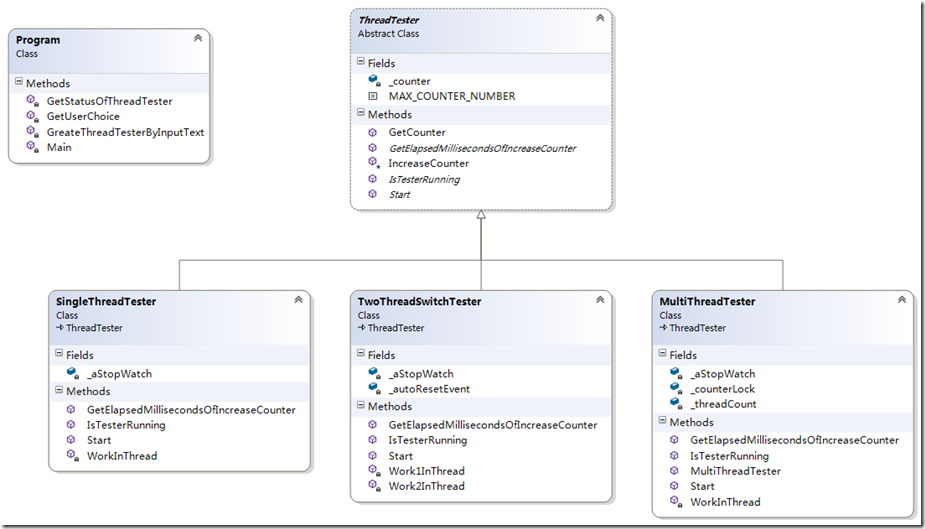线程上下文切换的性能损耗到底有多少,一直没有直观的理解,今天写个程序测试一下。先看看下面的程序(点击下载):

ThreadTester是所有Tester的基类。所有的Tester都干的是同样一件事情,把counter增加到100000000,每次只能加1。
monospace; width: 100%; border-bottom-style: none; color: black; padding-bottom: 0px; direction: ltr; text-align: left; padding-top: 0px; border-right-style: none; padding-left: 0px; margin: 0em; border-left-style: none; line-height: 12pt; padding-right: 0px; background-color: #f4f4f4"> 1: public abstract class ThreadTester
2: {3: public const long MAX_COUNTER_NUMBER = 100000000;
4: 5: private long _counter = 0;
6: 7: //获得计数
8: public virtual long GetCounter()
9: {10: return this._counter;
11: } 12: 13: //增加计数器
14: protected virtual void IncreaseCounter()
15: {16: this._counter += 1;
17: } 18: 19: //启动测试
20: public abstract void Start();
21: 22: //获得Counter从开始增加到现在的数字所耗的时间
23: public abstract long GetElapsedMillisecondsOfIncreaseCounter();
24: 25: //测试是否正在运行
26: public abstract bool IsTesterRunning();
27: }
SingleThreadTester是单线程计数。
1: class SingleThreadTester : ThreadTester
2: {3: private Stopwatch _aStopWatch = new Stopwatch();
4: 5: public override void Start()
6: { 7: _aStopWatch.Start(); 8: 9: Thread aThread = new Thread(() => WorkInThread());
10: aThread.Start(); 11: } 12: 13: public override long GetElapsedMillisecondsOfIncreaseCounter()
14: {15: return this._aStopWatch.ElapsedMilliseconds;
16: } 17: 18: public override bool IsTesterRunning()
19: {20: return _aStopWatch.IsRunning;
21: } 22: 23: private void WorkInThread()
24: {25: while (true)
26: {27: if (this.GetCounter() > ThreadTester.MAX_COUNTER_NUMBER)
28: { 29: _aStopWatch.Stop();30: break;
31: } 32: 33: this.IncreaseCounter();
34: } 35: } 36: }
TwoThreadSwitchTester是两个线程交替计数。
1: class TwoThreadSwitchTester : ThreadTester
2: {3: private Stopwatch _aStopWatch = new Stopwatch();
4: private AutoResetEvent _autoResetEvent = new AutoResetEvent(false);
5: 6: public override void Start()
7: { 8: _aStopWatch.Start(); 9: 10: Thread aThread1 = new Thread(() => Work1InThread());
11: aThread1.Start(); 12: 13: Thread aThread2 = new Thread(() => Work2InThread());
14: aThread2.Start(); 15: } 16: 17: public override long GetElapsedMillisecondsOfIncreaseCounter()
18: {19: return this._aStopWatch.ElapsedMilliseconds;
20: } 21: 22: public override bool IsTesterRunning()
23: {24: return _aStopWatch.IsRunning;
25: } 26: 27: private void Work1InThread()
28: {29: while (true)
30: { 31: _autoResetEvent.WaitOne(); 32: 33: this.IncreaseCounter();
34: 35: if (this.GetCounter() > ThreadTester.MAX_COUNTER_NUMBER)
36: { 37: _aStopWatch.Stop();38: break;
39: } 40: 41: _autoResetEvent.Set(); 42: } 43: } 44: 45: private void Work2InThread()
46: {47: while (true)
48: { 49: _autoResetEvent.Set(); 50: _autoResetEvent.WaitOne();51: this.IncreaseCounter();
52: 53: if (this.GetCounter() > ThreadTester.MAX_COUNTER_NUMBER)
54: { 55: _aStopWatch.Stop();56: break;
57: } 58: } 59: } 60: }
MultiThreadTester可以指定线程数,多个线程争抢计数。
1: class MultiThreadTester : ThreadTester
2: {3: private Stopwatch _aStopWatch = new Stopwatch();
4: private readonly int _threadCount = 0;
5: private readonly object _counterLock = new object();
6: 7: public MultiThreadTester(int threadCount)
8: {9: this._threadCount = threadCount;
10: } 11: 12: public override void Start()
13: { 14: _aStopWatch.Start(); 15: 16: for (int i = 0; i < _threadCount; i++)
17: {18: Thread aThread = new Thread(() => WorkInThread());
19: aThread.Start(); 20: } 21: } 22: 23: public override long GetElapsedMillisecondsOfIncreaseCounter()
24: {25: return this._aStopWatch.ElapsedMilliseconds;
26: } 27: 28: public override bool IsTesterRunning()
29: {30: return _aStopWatch.IsRunning;
31: } 32: 33: private void WorkInThread()
34: {35: while (true)
36: {37: lock (_counterLock)
38: {39: if (this.GetCounter() > ThreadTester.MAX_COUNTER_NUMBER)
40: { 41: _aStopWatch.Stop();42: break;
43: } 44: 45: this.IncreaseCounter();
46: } 47: } 48: } 49: }
Program的Main函数中,根据用户的选择来决定执行哪个测试类。
1: class Program
2: {3: static void Main(string[] args)
4: { 5: 6: string inputText = GetUserChoice();
7: 8: while (!"4".Equals(inputText))
9: { 10: ThreadTester tester = GreateThreadTesterByInputText(inputText); 11: tester.Start(); 12: 13: while (true)
14: { 15: Console.WriteLine(GetStatusOfThreadTester(tester));16: if (!tester.IsTesterRunning())
17: {18: break;
19: } 20: Thread.Sleep(100); 21: } 22: 23: inputText = GetUserChoice(); 24: } 25: 26: Console.Write("Click enter to exit...");
27: } 28: 29: private static string GetStatusOfThreadTester(ThreadTester tester)
30: {31: return string.Format("[耗时{0}ms] counter = {1}, {2}",
32: tester.GetElapsedMillisecondsOfIncreaseCounter(), tester.GetCounter(),33: tester.IsTesterRunning() ? "running" : "stopped");
34: } 35: 36: private static ThreadTester GreateThreadTesterByInputText(string inputText)
37: {38: switch (inputText)
39: {40: case "1":
41: return new SingleThreadTester();
42: case "2":
43: return new TwoThreadSwitchTester();
44: default:
45: return new MultiThreadTester(100);
46: } 47: } 48: 49: private static string GetUserChoice()
50: {51: Console.WriteLine(@"==Please select the option in the following list:==
52: 1. SingleThreadTester 53: 2. TwoThreadSwitchTester 54: 3. MultiThreadTester 55: 4. Exit"); 56: 57: string inputText = Console.ReadLine();
58: 59: return inputText;
60: } 61: }
三个测试类,运行结果如下:
Single Thread:
[耗时407ms] counter = 100000001, stopped
[耗时453ms] counter = 100000001, stopped
[耗时412ms] counter = 100000001, stopped
Two Thread Switch:
[耗时161503ms] counter = 100000001, stopped
[耗时164508ms] counter = 100000001, stopped
[耗时164201ms] counter = 100000001, stopped
Multi Threads - 100 Threads:
[耗时3659ms] counter = 100000001, stopped
[耗时3950ms] counter = 100000001, stopped
[耗时3720ms] counter = 100000001, stopped
Multi Threads - 2 Threads:
[耗时3078ms] counter = 100000001, stopped
[耗时3160ms] counter = 100000001, stopped
[耗时3106ms] counter = 100000001, stopped
上下文切换的精确定义可以参考: http://www.linfo.org/context_switch.html。多任务系统往往需要同时执行多道作业。作业数往往大于机器的CPU数,然而一颗CPU同时只能执行一项任务,为了让用户感觉这些任务正在同时进行,操作系统的设计者巧妙地利用了时间片轮转的方式,CPU给每个任务都服务一定的时间,然后把当前任务的状态保存下来,在加载下一任务的状态后,继续服务下一任务。任务的状态保存及再加载,这段过程就叫做上下文切换。时间片轮转的方式使多个任务在同一颗CPU上执行变成了可能,但同时也带来了保存现场和加载现场的直接消耗。(Note. 更精确地说, 上下文切换会带来直接和间接两种因素影响程序性能的消耗. 直接消耗包括: CPU寄存器需要保存和加载, 系统调度器的代码需要执行, TLB实例需要重新加载, CPU 的pipeline需要刷掉; 间接消耗指的是多核的cache之间得共享数据, 间接消耗对于程序的影响要看线程工作区操作数据的大小).

根据上面上下文切换的定义,我们做出下面的假设:
由于Windows下没有像Linux下的vmstat这样的工具,这里我们使用Process Explorer看看程序执行的时候线程上线文切换的次数。
Single Thread:

计数期间,线程总共切换了580-548=32次。(548是启动程序后,初始的数值)
Two Thread Switch:

计数期间,线程总共切换了33673295-124=33673171次。(124是启动程序后,初始的数值)
Multi Threads - 100 Threads:

计数期间,线程总共切换了846-329=517次。(329是启动程序后,初始的数值)
Multi Threads - 2 Threads:

计数期间,线程总共切换了295-201=94次。(201是启动程序后,初始的数值)
从上面收集的数据来看,和我们的判断基本相符。
再想想原来学过的知识,之前一直以为线程多干活就快,简直是把学过的计算机原理都还给老师了。真正干活的不是线程,而是CPU。线程越多,干活不一定越快。
那么高并发的情况下什么时候适合单线程,什么时候适合多线程呢?
适合单线程的场景:单个线程的工作逻辑简单,而且速度非常快,比如从内存中读取某个值,或者从Hash表根据key获得某个value。Redis和Node.js这类程序都是单线程,适合单个线程简单快速的场景。
适合多线程的场景:单个线程的工作逻辑复杂,等待时间较长或者需要消耗大量系统运算资源,比如需要从多个远程服务获得数据并计算,或者图像处理。
例子程序:http://pan.baidu.com/s/1ntNUPWP